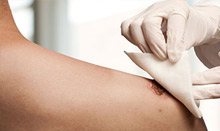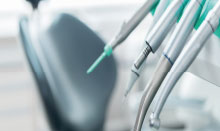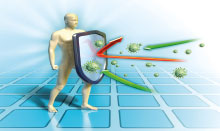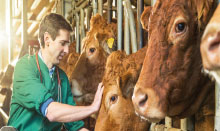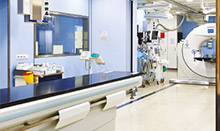Coronavirus
Coronaviruses are a group of viruses that cause disease in mammals and birds. Coronaviruses are common in many animal species, especially bats and camels. In humans, it typically causes respiratory infections, including mild colds.
More rare forms, such as SARS, MERS, and the novel Coronavirus that caused the COVID-19 Wuhan coronavirus outbreak, could be fatal. Coronaviruses cause diarrhea in cows and pigs and upper respiratory disease in chickens. Coronaviruses are surrounded by round, spiny proteins, so they look like a crown or sun halo and take their name from this structure. Coronaviruses are enveloped, positive single-stranded and spiral symmetry RNA viruses. Coronaviruses can be genetically quite different from each other.
Coronaviruses are located in the Nidovirales group, within the Coronaviridae family and the Orthocoronavirinae subfamily. There are four Coronavirus subgroups. Some Coronaviruses can rarely be transmitted from animals to humans and cause infection. These clinical pictures can be very mild or fatal. There are no vaccines or antiviral medications approved for prevention or treatment.
What are Human Coronavirus?
Human Coronaviruses were identified in the 1960s. Today, there are seven Coronavirus known to be infectious agents in humans.
Coronavirus, which is common in humans and affects the upper and lower respiratory tract;
* 229E (Alpha Coronavirus)
* NL63 (Alpha Coronavirus)
* OC43 (Beta Coronavirus)
* HKU1 (Beta Coronavirus)
Coronaviruses that have been identified and made epidemics in recent years;
SARS-CoV: It was defined in China in 2002. It causes severe acute respiratory syndrome (SARS). In 2002 and 2003, it caused an epidemic worldwide and 774 people died.
MERS-CoV: It originated in Saudi Arabia in 2012 and has been seen in many countries to date. It has been named the Middle East respiratory syndrome virus (MERS).
COVID-19: It was identified in Wuhan, China’s Hubei province, with an epidemic of pneumonia in humans in December 2019. COVID-19 was first identified as a serious lower respiratory tract infection in Wuhan, China. As a result of the researches, it has been understood that the agent is different from the defined viruses. The genome structure of the virus was quickly defined and the cases were quickly detected. Although there is still no clear information, it is thought that the source may be bats or snakes that feed on bats. The number of cases has increased over time and it has been observed that the virus can spread from person to person with the development of infection in the network workers.
How did the epidemic progress?
To date, the majority of cases are in China, but other countries have been described, especially in individuals who have traveled to China. The disease is also transmitted from patients to healthcare workers.
As of 02.02.2020 , 14457 confirmed cases and 305 (1 out of China) deaths have been reported in the world due to COVID-19 . You can follow the current figures at ” https://actopharma.com/2019-ncov-global-cases-corona-virus-update-online/ ” .
Regarding COVID-19 , on January 30, 2020; * World Health Organization (WHO) declared “International Emergency”. WHO – The emergency announcement is not related to the course and spread of the disease, but to provide support to countries with limited means.
In the last suggestions; There are measures such as ensuring early identification and source control, applying droplet and contact isolation for all patients and applying similar standard measures, applying respiratory isolation measures, administrative controls and environmental and engineering controls when applicable.
In which patients should 2019-nCoV infection be suspected?
Early identification of patients with suspected COVID-19 infection is very important to ensure source control. A detailed travel history should be questioned in patients presenting with fever and acute respiratory disease (cough, respiratory distress, etc.).
People with a history of travel to China within 14 days prior to the onset of symptoms, a patient investigated for COVID-19 , or patients who have contact with a laboratory – proven COVID-19 patient should be immediately taken to a separate area from other patients and must be immediately reported to health authorities . (Detailed information: TR Ministry of Health, General Directorate of Public Health, COVID-19 Disease Healthcare Professionals Guide).
What samples should be collected for diagnosis, when and how?
Clinical samples should be collected from patients as soon as possible regardless of the onset of symptoms to test respiratory pathogens, but cell culture and similar viral isolation procedures should not be performed for biosecurity reasons, samples should be sent to relevant and authorized institutions immediately.
Three sample types for testing;
- Lower breathing (sputum, deep tracheal aspirate, bronchoalveolar lavage),
- Upper breathing (nasopharyngeal or oropharyngeal swab, nasopharyngeal wash / aspirate, nasal aspirate)
- Serum samples
Appropriate infection control should be provided while collecting specimens. Samples should be stored at 2-8 o C and sent to the relevant laboratory in an ice pack. Patient information, sample type, date and time of collection must be written on the samples.
- Nasopharyngeal and oropharyngeal swab samples should only be taken with plastic synthetic fiber sticks, calcium alginate sticks or sticks with wooden shafts should not be used.
- Serum samples should be collected in the form of 1-5 ml whole blood samples from children and adults and 1 ml from infants. Tubes should be stored upright for at least 30 minutes and then centrifuged at 1000-1300 relative centrifugal force (RCF) for 10 minutes.
Ltd. suspicious how patients should be isolated?
Suspected patients should be asked to wear a surgical mask as soon as they are detected, and patients should be monitored in a sufficiently ventilated single room (160 L / sec / patient for naturally ventilated general ward rooms) with the door closed, and ideally in a negative pressure isolation room. Cohort administration should be done in cases where there is no single room and when the conditions are insufficient.
All individuals who will come into contact with the patient, including family members, visitors and healthcare professionals, must strictly comply with droplet and contact isolation measures in addition to standard precautions; wear a surgical mask, clean, non-sterile disposable, long sleeved liquid-resistant gowns, gloves, eye protection (eg goggles or face shield). Respiratory isolation measures should also be followed whenever possible.
Single-use disposable or patient-specific equipment (e.g. stethoscopes, blood pressure cuffs, and thermometers) should be used, or if shared between patients in cohort administration, equipment should be clean and disinfected between each patient use (e.g. ethyl alcohol 70%).
In any case, hand hygiene must be followed.
It is an effective and sufficient procedure to clean the surrounding surfaces that are or may come into contact with the patient and body fluids regularly with water and detergent and the application of disinfectants commonly used in the hospital (such as sodium hypochlorite). Laundry, food service equipment and medical waste can be managed with safe routine procedures.
How should patient transport be done?
If the patient needs to be transported, the staff, other patients, visitors and the patient should be dressed in a surgical mask, the destination of the patient should be informed in advance and the necessary standard precautions should be applied. Healthcare workers carrying patients should also use the previously specified protective equipment and comply with hand hygiene.
What should be considered during transport by ambulance?
Personal protective equipment should be kept ready during transport by ambulances, and personal protective equipment should be used from the first intervention to the delivery of the patient.
Care should be taken to use an N95 / FFP3 mask and face shield in cases where any intervention will be made that may cause aerosolization of the patient’s secretions or body outputs .
After the transport, ambulances should be cleaned and disinfected.
What should be done in case of contact with a suspect patient?
The number of healthcare workers, family members and visitors in contact with a patient with suspected COVID-19 infection should be limited; Records should be kept of all persons entering the patient’s room, including all staff and visitors. All these precautions should be followed until the patient is asymptomatic.
Those who have had close contact with a person who has been confirmed for COVID-19 infection or whose evaluation is ongoing, their fever should be measured twice a day for 14 days after their last contact, cough, respiratory distress and chills, body aches, sore throat, headache, diarrhea, stomach Presence of other early symptoms such as nausea / vomiting and runny nose should follow up.


